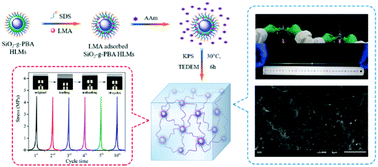Highly tough, anti-fatigue and rapidly self-recoverable hydrogels reinforced with core–shell inorganic–organic hybrid latex particles
Abstract
The introduction of SiO2 particles as crosslinking points into hydrogels has been recognized as a suitable way for toughening hydrogels, due to their versatile functionalization and large specific surface area. However, chemically linked SiO2 nanocomposite hydrogels often exhibited negligible fatigue resistance and poor self-recoverable properties due to the irreversible cleavage of covalent bonds. Here, we proposed a novel strategy to improve stretchability, fatigue resistance and self-recoverable properties of hydrogels by using SiO2-g-poly(butyl acrylate) core–shell inorganic–organic hybrid latex particles as hydrophobic crosslinking centers for hydrophobic association. The obtained hydrogel could distribute the surrounding applied stress by disentanglement of the hybrid latex particles from hydrophobic segments. Based on this strategy, the formulated hydrogels showed an excellent tensile strength of 1.48 MPa, superior stretchability of 2511% and remarkable toughness of 12.62 MJ m−3. Moreover, the hydrogels owned extraordinary anti-fatigue, rapid self-recovery and puncture resistance properties. Therefore, this strategy provided a novel pathway for developing advanced soft materials with potential applications in biomedical engineering, such as tendons, muscles, cartilages, etc.



 Please wait while we load your content...
Please wait while we load your content...